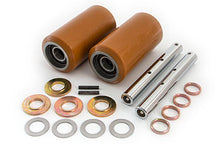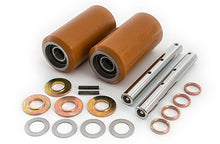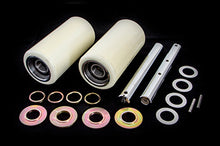Pallet Jack Wheel Kits: The Complete Guide
Pallet jack wheel kits are the replacement parts that keep pallet jacks running smoothly, safely and maneuverable in warehouses and industrial environments. This guide will walk you through how to choose, install and maintain pallet jack wheels.
1. What Is a Pallet Jack Wheel Kit?
A pallet jack wheel kit includes all the parts to replace the load and steer wheels on a pallet jack.
These kits contain:
- Load wheels (at the tips of the forks)
- Steer wheels (near the handle)
- Bearings, axles and fasteners
Each kit is designed for specific pallet jack models. Kits vary in diameter, material and mounts so you can match your equipment and surface. These are categorized by brand and fork type so you get the right fit.
2. Types of Pallet Jack Wheel Kits
Pallet jack wheel kits come in nylon, polyurethane or rubber and are load wheel or steer wheel kits.
- Nylon: Best for smooth concrete floors and heavy loading; low rolling resistance but loud.
- Polyurethane (Poly tread): Quieter, ideal for delicate floor surfaces like epoxy or tile.
- Rubber: Rare for indoor use; offers traction but wears faster.
Load wheels support the forks under the pallet. Steer wheels help movement and direction. Kits usually come in pairs, with sizes ranging from 2.75" to 4" in diameter, depending on the load.
3. When to Replace Pallet Jack Wheels
Replace pallet jack wheels when they show wear, make noise or reduce rolling.
Signs of wear include:
- Flat spots or cracks
- Hard to roll or turn
- Loud squeaking or grinding
- Damage to floors from hard wheel edges
- Increased resistance during loading. Worn rollers can compromise pallet jack performance and lead to equipment failure or injury. On average, replace wheels every 6–12 months depending on usage and surface conditions.
4. How to Choose
To choose the right kit, match your pallet jack model, load capacity, surface type and material preference.
Key factors:
- Model Compatibility: Use the serial number or part code to match exact pallet jack parts
- Material Fit: Nylon for durability, polyurethane for quiet use
- Weight Rating: Match to your jack’s max load (usually 4,400–5,500 lbs)
- Surface Type: Use polyurethane on smooth or painted floors to avoid marking
Most websites have filters by brand, size and category to help you find the best match. Always check if axles, bearings and hardware are included before purchase.
5. How to Install
To install a pallet jack wheel kit, disassemble the forks, remove old wheels and attach new wheels using a wrench and safety tools.
Steps to install:
- Lift the jack using a hoist or support blocks.
- Remove axle nuts or clips using a socket wrench.
- Slide out the worn wheels and clean the housing.
- Install new wheels, ensuring bearings are seated properly.
- Tighten all hardware and test for smooth roll.
For beginners, some websites offer a video guide for visual reference. Make sure to torque properly to avoid over-tightening which may damage parts.
6. Best Brands and Where to Buy
Top rated pallet jack wheel kits are offered by Liftsplus.com
Compare by:
- Material quality
- Cost (average range: $25–$80)
- Warranty (usually 6–12 months)
- Customer reviews
Liftsplus.com lists compatibility by jack model so you can add the correct kit to your cart.
7. Tips to Maintain and Extend Wheel Life
Regular maintenance keeps pallet jack wheels running smooth and extends their lifespan.
Checklist:
- Inspect weekly for debris, chips or wobble
- Clean wheels and axles to prevent buildup
- Lubricate bearings monthly with industrial-grade grease
- Don’t overload or drag across uneven surfaces
- Store pallet jacks indoors in dry conditions
Regular maintenance improves wheel roll, reduces replacement and floor wear.
⚙️ Conclusion
Pallet jack wheel kits are crucial for load handling, noise and safety.
To get the best:
- Match your jack and environment
- Choose high quality materials (polyurethane or nylon)
- Replace wheels when worn
- Follow installation and maintenance instructions
Use this guide to find, install and maintain the right kit for your warehouse equipment. Always verify parts compatibility before ordering.



